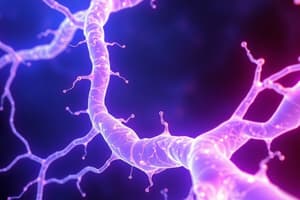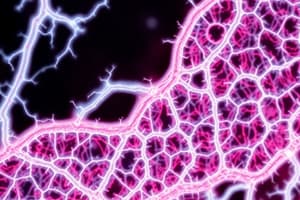Podcast
Questions and Answers
Which type of connective tissue is characterized by a rich matrix in hyaluronic acid and is widely distributed around blood vessels?
Which type of connective tissue is characterized by a rich matrix in hyaluronic acid and is widely distributed around blood vessels?
- White fibrous CT
- Loose (ordinary) CT (correct)
- Yellow elastic CT
- Mucoid CT
What distinguishes white fibrous connective tissue from loose connective tissue?
What distinguishes white fibrous connective tissue from loose connective tissue?
- Soft matrix rich in mucin
- Rich in fat cells
- Presence of elastic fibers
- Arranged collagenous bundles (correct)
In which location would yellow elastic connective tissue primarily be found?
In which location would yellow elastic connective tissue primarily be found?
- Around blood vessels
- Sclera of the eye
- Wall of arteries (correct)
- Pulp of teeth
Which type of adipose connective tissue is primarily associated with rapid heat production?
Which type of adipose connective tissue is primarily associated with rapid heat production?
Mucoid connective tissue is primarily found in which of the following locations?
Mucoid connective tissue is primarily found in which of the following locations?
Reticular connective tissue primarily forms a network in which of the following organs?
Reticular connective tissue primarily forms a network in which of the following organs?
What type of connective tissue has a characteristic structure of multilocular fat cells?
What type of connective tissue has a characteristic structure of multilocular fat cells?
Which connective tissue type contains irregular bundles of collagenous fibers and is found in tendons?
Which connective tissue type contains irregular bundles of collagenous fibers and is found in tendons?
What is the primary function of macrophages?
What is the primary function of macrophages?
What type of stain is used to visualize unilocular fat cells?
What type of stain is used to visualize unilocular fat cells?
Which cell type is characterized by a nucleus that is rounded and central, with basophilic granules?
Which cell type is characterized by a nucleus that is rounded and central, with basophilic granules?
What is the primary role of plasma cells in the immune response?
What is the primary role of plasma cells in the immune response?
What type of fat cell is characterized by numerous small fat droplets and a central nucleus?
What type of fat cell is characterized by numerous small fat droplets and a central nucleus?
Which type of leukocyte is primarily involved in responding to allergic reactions?
Which type of leukocyte is primarily involved in responding to allergic reactions?
Which cells originate from blood monocytes?
Which cells originate from blood monocytes?
What is a defining characteristic of mast cell granules?
What is a defining characteristic of mast cell granules?
What characterizes the fibers found in connective tissue proper?
What characterizes the fibers found in connective tissue proper?
Which type of connective tissue proper fiber is primarily found in tendons and ligaments?
Which type of connective tissue proper fiber is primarily found in tendons and ligaments?
Which component of connective tissue proper is responsible for providing a flexible and supportive matrix?
Which component of connective tissue proper is responsible for providing a flexible and supportive matrix?
What is the predominant characteristic of reticular fibers?
What is the predominant characteristic of reticular fibers?
Which cell type in connective tissue is known to be the mother cell of all connective tissue cells?
Which cell type in connective tissue is known to be the mother cell of all connective tissue cells?
What color do elastic fibers stain with Van Gieson’s stain?
What color do elastic fibers stain with Van Gieson’s stain?
In which locations would one typically find dense connective tissue proper?
In which locations would one typically find dense connective tissue proper?
Which of the following is NOT a type of cell found in connective tissue proper?
Which of the following is NOT a type of cell found in connective tissue proper?
Flashcards are hidden until you start studying
Study Notes
Connective Tissue Proper
- Connective tissue proper (CTP) is a type of connective tissue with a soft matrix.
- CTP is composed of three main components: fibers, cells, and matrix.
Fibers
-
Collagen fibers:
- Appear white in fresh state
- Are strong and resist stretching
- Form wavy bundles that branch
- Can be boiled into gelatin
- Digested by pepsin and collagenase
- Stain acidophilic with H&E
- Stain blue with Mallory trichrome stain
- Stain red with Van Gieson’s stain
- Classified into type I, II, and III collagen
- Type I collagen is found in bone and white fibrocartilage.
- Type II collagen is found in hyaline and yellow elastic fibrocartilage.
- Type III collagen forms reticular fibers.
-
Elastic fibers:
- Appear yellow in fresh state
- Are elastic
- Are thin and long
- Branch and may form elastic membranes, such as in the wall of the aorta
- Resist boiling
- Digested by elastase enzyme
- Stain acidophilic with H&E
- Stain yellow with Van Gieson’s stain
- Stain black with Ver-Hoeff’s stain
- Found in the walls of arteries, trachea, and ligaments between vertebrae.
-
Reticular fibers:
- Are very thin and form a network through branching and anastomosing
- Stain black with silver
- Not stained with H&E
- Found in the stroma of organs such as the liver, spleen, and lymph nodes.
Matrix
- The matrix of CTP is composed of:
- Organic components:
- Amorphous component: Consists of proteins (collagen, elastin) and glycoproteins (proteins joined to carbohydrates).
- Proteoglycans: Consists of proteins joined to disaccharides and are major components of the ground substance, including
- Glycosaminoglycans (GAGs): Are polysaccharide chains with a high negative charge that attracts water, giving the ground substance its gel-like consistency.
- Tissue fluid:
- Consists of 60-70% water.
- Organic components:
Cells
-
Branched cells:
- Undifferentiated mesenchymal cells (UMCs):
- Are the mother cells of all CTP cells
- Have a branched shape
- Have an oval and large nucleus
- Stain basophilic due to their abundant ribosomes
- Fibroblasts:
- Originate from UMCs, pericytes, and other fibroblasts.
- Are numerous in loose CTP
- Have a branched or spindle-shaped appearance
- Have an oval, vesicular, and eccentric nucleus
- Have basophilic cytoplasm with a negative Golgi image
- Synthesize all types of CTP fibers and matrix
- Contribute to the growth of CT and healing of wounds.
- Macrophages:
- Originate from blood monocytes
- Have a large, branched shape with pseudopodia
- Have an oval or kidney-shaped nucleus
- Have unclear cytoplasm
- Stain with vital stains such as trypan blue
- Phagocytize foreign bodies such as bacteria and viruses
- Secrete collagenase and elastase enzymes
- May fuse to form multinucleated giant cells.
- Pigment cells:
- Contain melanin and are found in the skin and eye.
- Undifferentiated mesenchymal cells (UMCs):
-
Rounded or oval cells:
- Fat (adipose) cells:
- Unilocular fat cells:
- Have an oval shape
- Have a flat, peripheral nucleus
- Have a large fat globule that pushes the nucleus to one side
- Fat dissolves in H&E staining, leaving an empty space that looks like a signet ring
- Stain orange with Sudan III
- Stain black with Sudan black and osmic acid
- Function in fat storage and heat insulation.
- Multilocular fat cells:
- Are smaller than unilocular fat cells
- Have a rounded, central nucleus
- Have numerous small fat droplets in their cytoplasm
- Have numerous mitochondria
- Function in heat production.
- Unilocular fat cells:
- Mast cells:
- Are found in the mucosa of the gastrointestinal and respiratory tracts
- Have an oval shape
- Have a rounded, central nucleus
- Have large, basophilic granules in their cytoplasm
- The granules consist of:
- Sulphated glycosaminoglycans (heparin): an anticoagulant
- Protein (histamine): a vasoactive substance
- Stain purple with toluidine blue (metachromatic staining)
- Secrete heparin and histamine during allergy.
- Plasma cells:
- Originate from B lymphocytes
- Transition through a plasmablast stage
- Are found in lymphatic organs
- Have an oval shape
- Have a rounded, eccentric nucleus with a "cartwheel" appearance.
- Have deep basophilic cytoplasm with a negative Golgi image.
- Secrete antibodies, contributing to humoral immunity.
- Blood leucocytes (white blood cells):
- Include eosinophils, neutrophils, monocytes, and lymphocytes, each with specific functions in the immune system.
- Fat (adipose) cells:
Studying That Suits You
Use AI to generate personalized quizzes and flashcards to suit your learning preferences.




